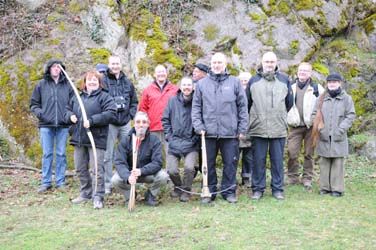|
The study regarding usability of bow slits
in fortified castles and their military benefit is more or less
finished.
Inspired by the visit of some Scottish
castles with impressive high slits during a research seminar of Dr.
Joachim Zeune BINSY performed some practical trials regarding the
usability of such slits in German castles of the 13th and 14th century
with long bows and crossbows in the years 2009 and 2010. By this
occasion more than 50 slits of castles in Alsace and Palatinate were analyzed, surveyed and filed in a database.
The „instruments“ for the trials – two self
long bows of maple wood and ash wood and two cross bows of oak and
cherry wood with steel bows were reproduced by Rüdiger Bernges from
BINSY according to medieval templates.
As an object for the trials some appropriate
castles in Alsace (France) had been chosen: in the first place the
Spesbourg castle near Andlau, additionally Ortenberg, Birkenfels,
Hoh-Andlau, Wangenbourg und Landsberg. Analyzed as well were the castles
Gräfenstein and Neu-Leiningen in the Palatine Forest (Germany) and
additional Schönburg castle in Oberwesel and Pfalzgrafenstein near Kaub,
both on the river Rhine.
The results were astonishing. Some castles
with their slits allow convenient bow shooting with appropriate shooting
angles to the left and to the right. The shooting angles using the
crossbows were always limited to a straightforward shot through the wall
because of the length of the bow. In this case cross slits were NOT
helpful to enlarge the shooting angles as supposed before (tested in the
keep of Wangenburg castle).
Some slits, e.g. those of Birkenfels castle,
were not usable at all. The openings of the slits were too narrow and
too low for using the bow in a secure and effective way. Only for a
straightforward shot with the crossbow these slits could be used. The
presumption of Dr. Zeune, that many castles only have slits for
deterrence, could be proved as true. Once again very interesting was
Ortenberg castle. Here the research shows that the building master has
planned and implemented the slits very systematically and with great
effects. The slits cover systematically jeopardized areas on the side of
possible attacks.
Interesting as well were the results about
the supposed security of a defender behind his slit. The practical
trials with the long bow show that even the not-well-trained bow
shooters from BINSY were able to shoot from outside the walls through
the slit into the inner embrasure. Well-trained bow men could “keep a
slit blind” for a while with permanent shooting - as the trials showed.
Extensive analyses, plans and measures of
the slits as well as detailed results are published in diverse
media: the scientific magazines Burgen und Schlösser (DBV), ARX (Südtiroler
Burgeninstitut) and the periodical of the Interessengemeinschaft
Historische Armbrust (Jens Sensfelder). Detailed information regarding
the slits can be found in the following BINSY database:

|


